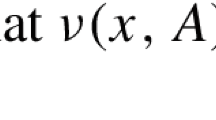Abstract
Consider a spectrally one-sided Lévy process X and reflect it at its past infimum I. Call this process Y. For spectrally positive X, Avram et al.(2) found an explicit expression for the law of the first time that Y=X−I crosses a finite positive level a. Here we determine the Laplace transform of this crossing time for Y, if X is spectrally negative. Subsequently, we find an expression for the resolvent measure for Y killed upon leaving [0,a]. We determine the exponential decay parameter ϱ for the transition probabilities of Y killed upon leaving [0,a], prove that this killed process is ϱ-positive and specify the ϱ-invariant function and measure. Restricting ourselves to the case where X has absolutely continuous transition probabilities, we also find the quasi-stationary distribution of this killed process. We construct then the process Y confined in [0,a] and prove some properties of this process.
Similar content being viewed by others
references
Asmussen, S. (1989). Applied Probability and Queues, Wiley series in probability.
Avram, F., Kyprianou, A. E., and Pistorius, M. R. (2004). Exit problems for spectrally negative Lévy processes and applications to (Canadized) Russian options. Ann. Appl. Probab. (forthcoming).
Bertoin, J. (1991). FrSur la décomposition de la trajectoire d'un processus de Lévy spectralement positif en son infimum. Ann. Inst. H. Poincaré Probab. Statist. 27, 537-547.
Bertoin, J. (1996). On the first exit time of a completely asymmetric stable process from a finite interval. Bull. London Math. Soc. 28, 514-520.
Bertoin, J. (1996). Lévy Processes, Cambridge University Press.
Bertoin, J. (1997). Exponential decay and ergodicity of completely asymmetric Lévy processes in a finite interval. Ann. Appl. Probab. 7, 156-169.
Bingham, N. H. (1975). Fluctuation theory in continuous time. Adv. Appl. Prob. 7, 705-766.
Borovkov, A. A. (1976). Stochastic Processes in Queueing Theory, Springer-Verlag.
Borodin, A. N., and Salminen, P. (1996). Handbook of Brownian Motion—Facts and Formulae, Birkhäuser.
Chaumont, L. (1993). FrSur certains processus de Lévy conditionés a rester positifs. Stochastics Stochastic Rep. 47, 1-20.
Chung, K. L. (1986). Doubly Feller process with multiplicative functional. In Seminar on Stochastic Processes, Birkhäuser, pp. 63-78.
Dellacherie, C., and Meyer, P. A. (1987). FrProbabilités et potentiel (tome 4), Hermann Paris.
Emery, D. J. (1973). Exit problem for a spectrally positive process. Adv. in Appl. Probab. 5, 498-520.
Hawkes, J. (1979). Potential theory of Lévy processes. Proc. London Math. Soc. 38, 335-352.
Jacod, J., and Shiryaev, A. N. (1987). Limit Theorems for Stochastic Processes, Springer-Verlag.
Knight, F. B. (1969). Brownian local times and taboo processes. Trans. Amer. Soc 73, 173-185.
Kyprianou, A. E., and Pistorius, M. R. (2003). Perpetual options and Canadization through fluctuation theory. Ann. Appl. Probab. 13, 1077-1098.
Lambert, A. (2000). Completely asymmetric Lévy processes confined in a finite interval. Ann. Inst. H. Poincaré Prob. Stat. 36, 251-274.
Winkel, M. (2002). Right inverses of non-symmetric Lévy processes. Ann. Probab. 30, 382-415.
Prabhu, N. U. (1997). Insurance, Queues, Dams, Springer-Verlag.
Robbins, H., and Siegmund, D. (1972). On the law of the iterated logarithm for maxima and minima. Proc. Sixth Berkerley Symp. 3, 51-70.
Protter, P. (1990). Stochastic Integration and Differential Equations, Springer-Verlag.
Rogers, L. C. G. (1984). On a new identity for real Lévy processes. Ann. Inst. Henri Poincaré 20, 21-34.
Spitzer, F. (1964). Principles of Random Walks, Van Nostrand, Princeton.
Suprun, V. N. (1976). The ruin problem and the resolvent of a killed independent increment process. Ukrainian Math. J. 28, 39-45.
Takács, L. (1966). Combinatorial Methods in the Theory of Stochastic Processes, Wiley, New York.
Tucker, H. G. (1962). Absolute continuity of infinitely divisible distributions. Pacific J. Math. 12, 1125-1129.
Tuominen, P., and Tweedie, R. (1979). Exponential decay and ergodic properties of general Markov processes. Adv. Appl. Prob. 11, 784-803.
Author information
Authors and Affiliations
Rights and permissions
About this article
Cite this article
Pistorius, M.R. On Exit and Ergodicity of the Spectrally One-Sided Lévy Process Reflected at Its Infimum. Journal of Theoretical Probability 17, 183–220 (2004). https://doi.org/10.1023/B:JOTP.0000020481.14371.37
Issue Date:
DOI: https://doi.org/10.1023/B:JOTP.0000020481.14371.37



